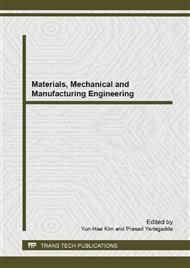p.263
p.267
p.271
p.275
p.279
p.284
p.289
p.293
p.297
Grain Refinement of Mg97Y2Cu1 Alloy Solidified with Pulsed Direct Current Magnetic Field
Abstract:
The influences of different pulse voltage, discharging frequency, pouring temperature and mold temperature on marostructure of Mg97Y2Cu1 alloy under pulsed direct current magnetic field (PDCMF) were studied and the related mechanism was also discussed. The results show that grains of Mg97Y2Cu1 alloy can be refined greatly by PDCMF treatment. Macrostructure of the alloy is changed from coarsened grains to complete fine equiaxed grains. When the pulse voltage is at 0-250V, grain size of the alloy decreases dramatically as pulse voltage increases. When the discharging frequency is at 1-10Hz, grain size of the alloy increases firstly, then decreases, and the turning point is 5 Hz. The change of grain size is not obvious, when the discharging frequency increases from 1 Hz to 5 Hz. When the discharging frequency reaches 10 Hz, the effect of grain refinement is the best. When the mold temperature is at 20-600°C or the pouring temperature is at 660-750°C, grain size of the alloy with PDCMF treatment decreases grossly with the increase of the mold temperature or the pouring temperature. The higher the pouring temperature or the mold temperature, the better the effect of grain refinement with PDCMF treatment.
Info:
Periodical:
Pages:
279-283
Citation:
Online since:
November 2013
Authors:
Price:
Сopyright:
© 2014 Trans Tech Publications Ltd. All Rights Reserved
Share:
Citation:


